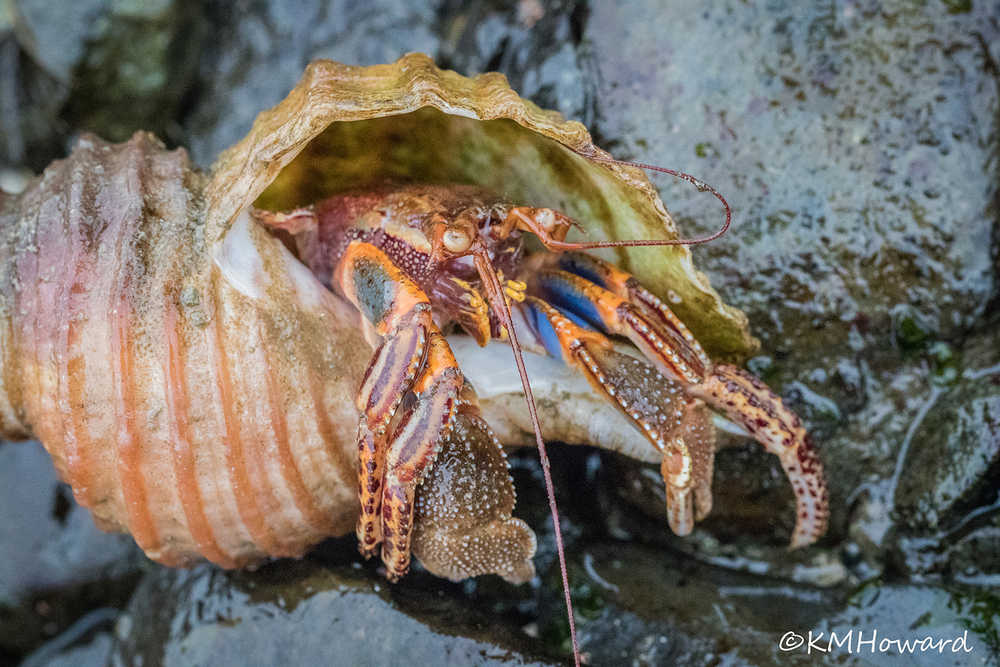Good low tides (minus four feet) during daylight hours on two days in early April brought us some superior tide-pooling opportunities. We try to do this with care: leaving our finds in the place and position in which we found them. It is grand fun to explore intertidal habitats that are seldom accessible. In addition to some quite familiar species, there are always several pleasant surprises. It’s hard for me to choose my favorite encounters on those April days, and my companions may make other choices, but here are some selections.
A prize find was a giant Pacific chiton (Cryptochiton stelleri), wedged in a rocky crevice. The plates of its back were entirely invisible, covered by the leathery mantle. This one was about eight or nine inches long, which vastly overshadows our other local chitons, but some individuals of this species get to be over a foot long. This species is said to be the largest chiton in the world.
A big favorite was the array of hermit crabs — I had no idea we have such a variety. Hermit crabs tuck their soft backsides into abandoned shells of snails, preferring shells large enough to cover the whole body. The need for protective shells of the right size can lead to some spectacular fights for possession, and one hermit sometimes evicts another to claim a shell. On one shoreline, most of the large hermits were housing themselves in large whelk shells. One of them was the showy wide-handed hermit (Elassochirus tenuimanus), with its bright blue patches on the legs. At another site, moon snail shells protected several gaudy, vivid orange-red hermits known as red Pacific hermit crabs (Elassochirus gilli). The huge right claw of both species is used to close the “door” of the shell when the crab retreats inside to safety.
We discovered a large Neptunea whelk, still living in its own shell. When we stood quietly for a short time, the critter slowly poked out its antennae, then a hefty snout, and finally a big foot, which it then used to creep along the rocks.
On one shoreline, many of the common five-armed sea stars (Evasterias troschelii) were sickly-looking or damaged. This sea star normally has a stiff body, but many of those on this shore were flabby. Some were missing an arm or two, due to illness or predator attack, and I found several lost arms lying on the bottom. Sea stars can regenerate lost arms when they are healthy, but we didn’t see much of that at this location. The second site had lots of apparently healthy Evasterias, in many colors.
Sunstars (probably Solaster dawsoni) were conspicuous, with bright red, narrow arms with yellowish margins. These were interesting because of the variation in the arms themselves. Some sunstars were regenerating a lost arm, so the new arm was just a growing stump. That’s expected. What wasn’t expected was a case in which two adjacent arms had fused together, and another case in which an arm was forked at the tip. Do these anomalies represent developmental problems or a response to injury?
A small depression in the rock held what looked, initially, like two small barnacles, but turned out to be Aristotle’s lanterns. The lantern (so-called for its shape, and named for its discoverer) is the feeding apparatus of sea urchins. It is a complex arrangement of five tiny teeth that work together when the urchin grazes on algae. The teeth are gradually worn down by use but they grow continually, so they are always ready to nibble. A crow or a gull probably ate the urchins and left the lanterns behind. We saw lots of broken, empty shells of urchins, but this find was a first for me.
A very special treat was encountering a visiting expert on algae, who gave us a fine, impromptu lesson about one of our local species of red alga (Constantinea rosa-marina) — and which we later found for ourselves. This species is perennial, with flat, round fronds produced each year. In the breeding season, males have a white rim around the frond where the sperm are produced, after which the white rim drops off. Females catch released sperm with special hairs on their fronds. This alga belongs to a taxonomic group that has known healing properties, against the human cold-sore virus, for example.
There were other sources of pleasure (in addition to the excellent company). Little red king crabs of several sizes scuttled about. There were tiny sea urchins and sea stars no bigger than two millimeters across. Shrimp that seemed to be of at least two different types flipped around in shallow pools at one site. We found a weird little jelly-bean sea cucumber with a surprisingly firm, semi-translucent body. Some of the sea stars were humped up in the center, holding a clam or other prey that was slowly being digested. One apparently dead five-armed sea star was surrounded by three large Christmas anemones, each of which held the tip of an arm in its mouth, perhaps having lunch.
To top it all off: Black oystercatchers called and flew from rock to rock. And ruby-crowned kinglets and song sparrows were singing in the background.
• Mary F. Willson is a retired professor of ecology.

